Zhaoxin KaiXian x86 CPU Tested: The Rise of China's Chips
Taking on the x86 duopoly
Test Notes
The firmware in the Zhoaxin-provided development board is certainly a spartan affair, so there are very few options. Overclocking is off the table, as are any type of memory manipulations. However, we did find an option to disable AVX, but we're told this feature is to address compatibility with some applications. We found that it did offer heightened performance in some workloads, and we've included those results in the relevant tests.
Rendering
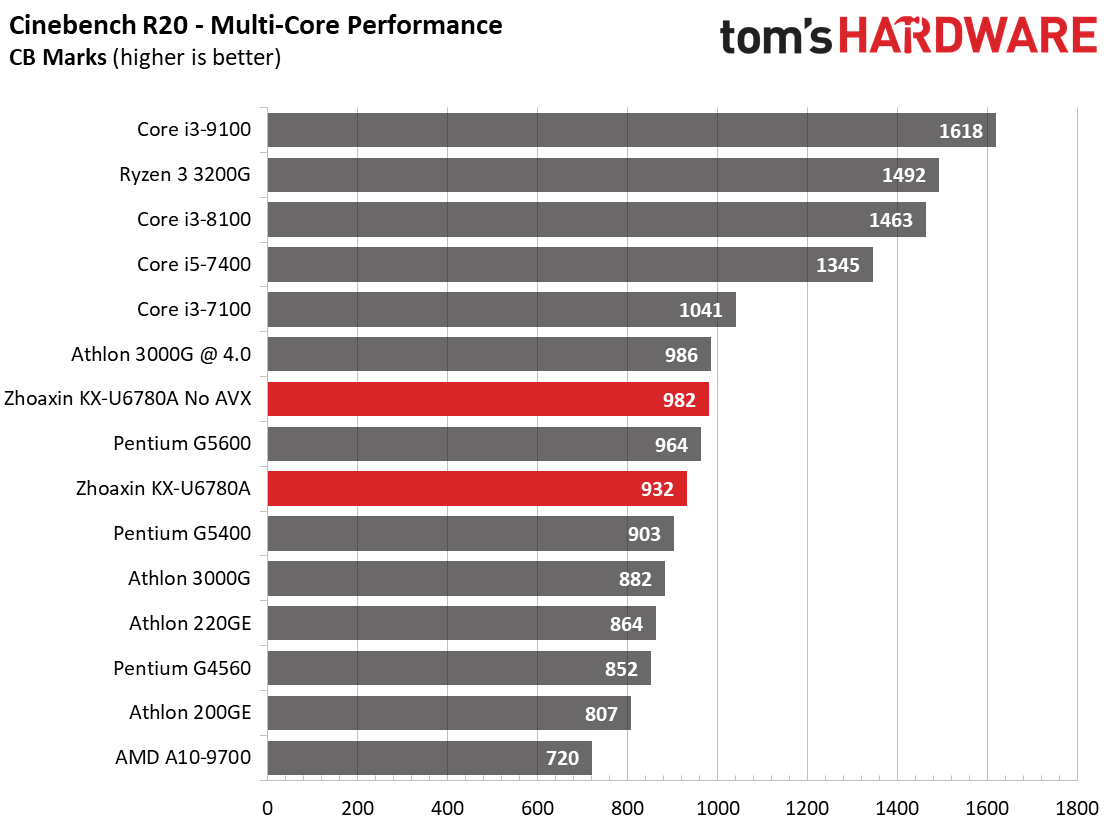
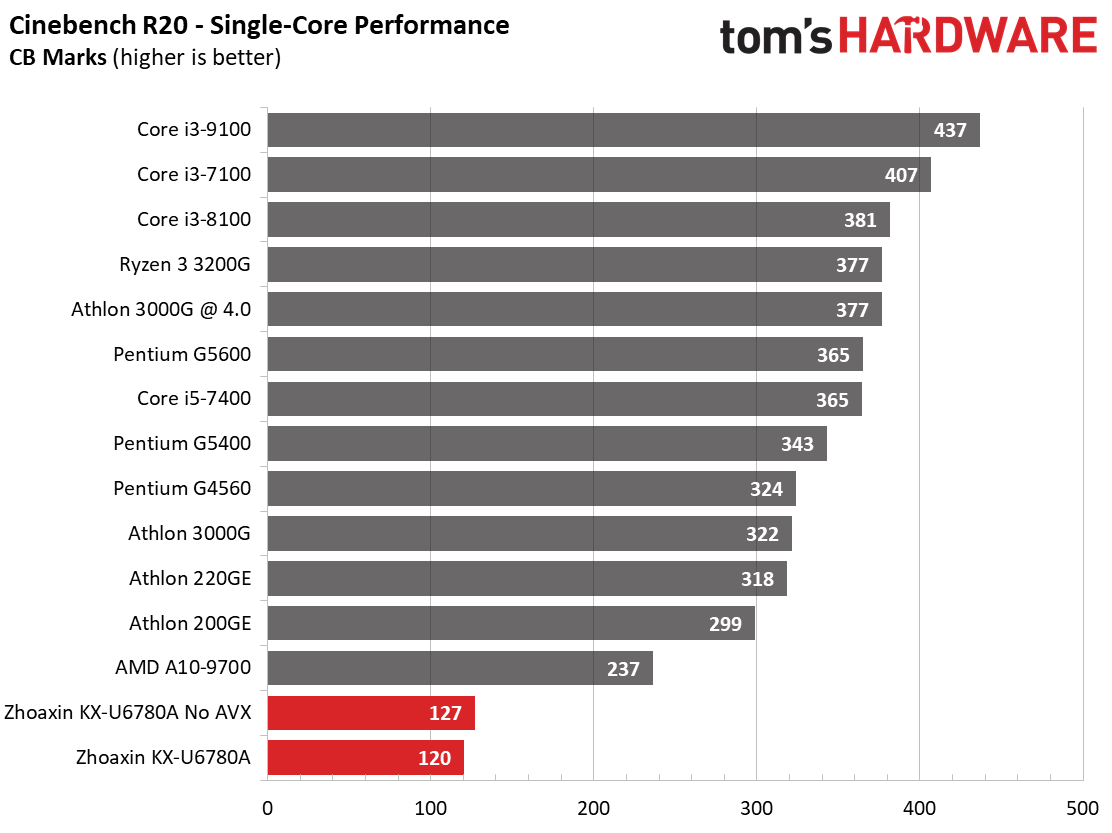

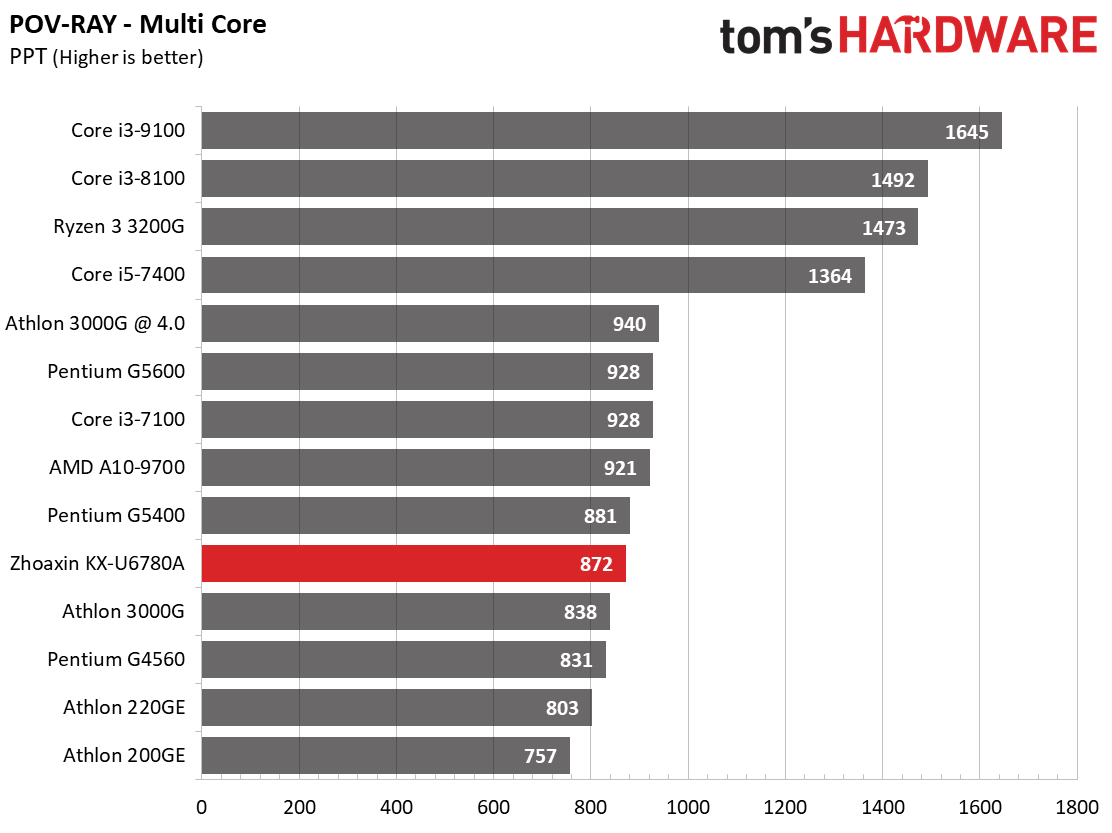

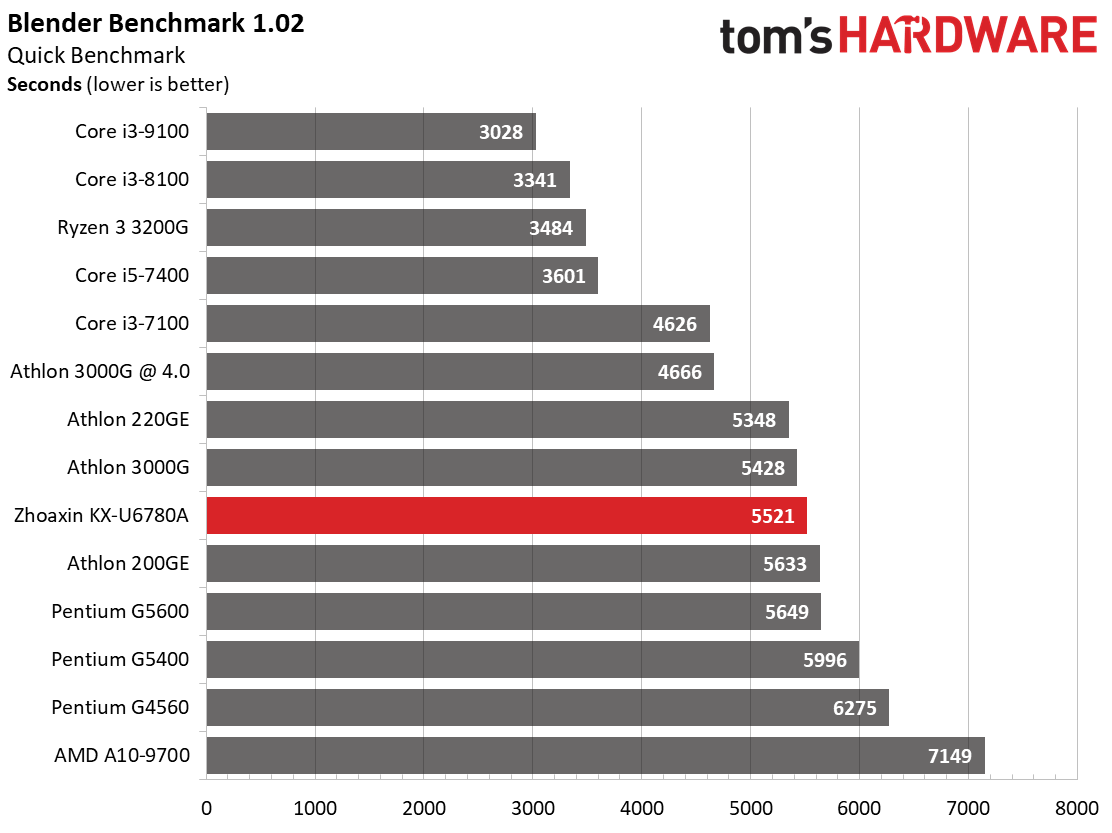
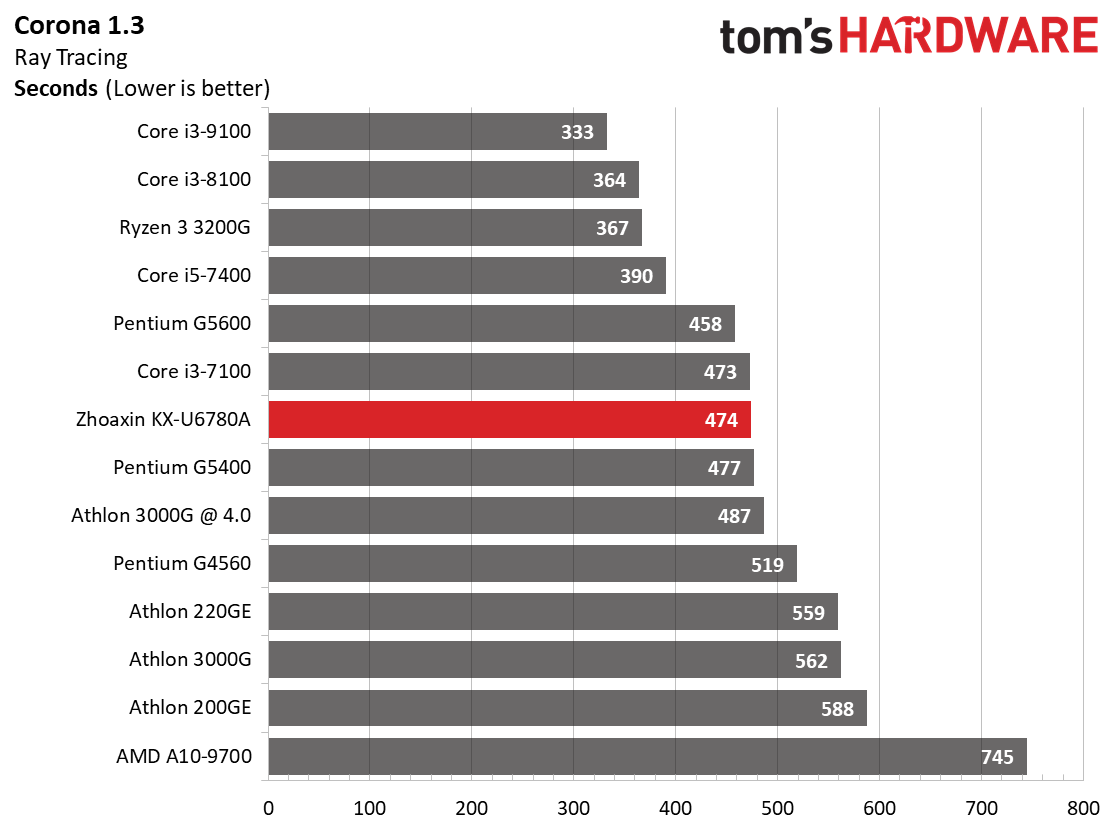
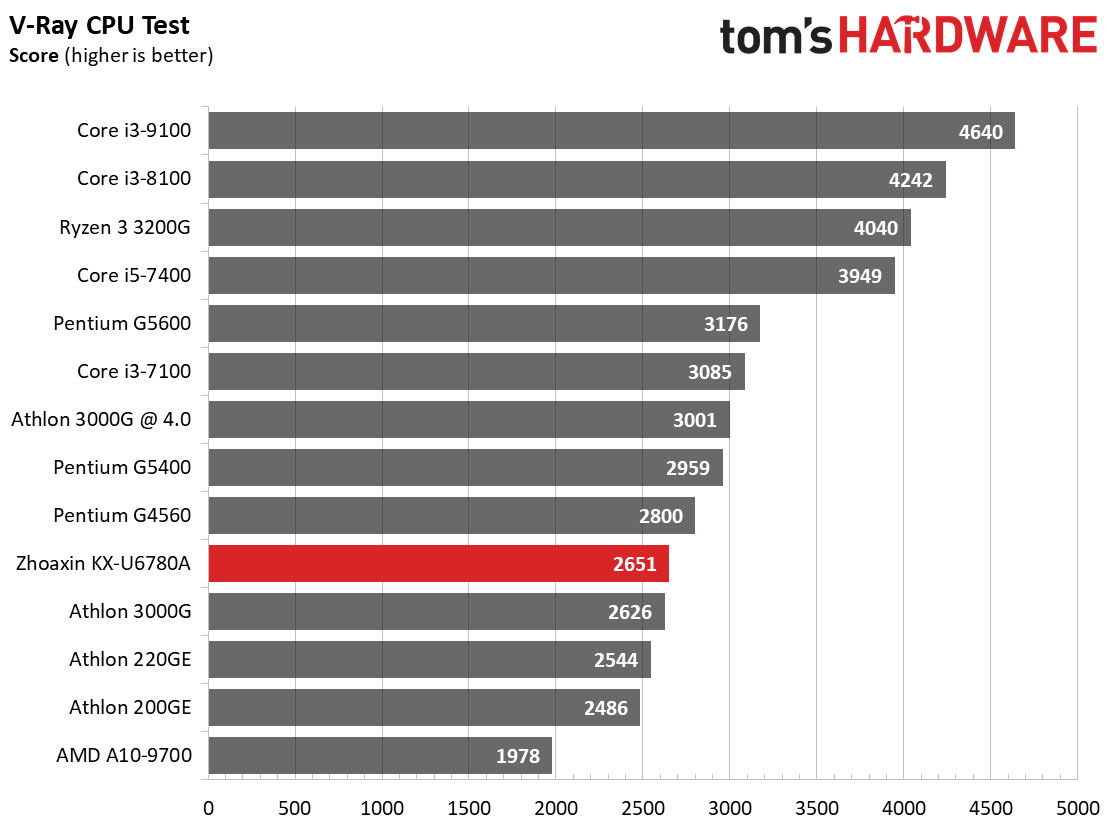
We expect heavily-threaded workloads to expose the best of the eight-core Zhaoxin's performance, but that only manifested in a few workloads – the majority of the tests find the processor lagging behind dual-core competitors. The chip does climb the ranks quite a bit more than it did in the gaming benchmarks, but it's clear that its single-threaded performance is lacking.
For instance, the Zhaoxin chip trailed competing models tremendously in the single-threaded Cinebench test, but through the virtue of its extra cores it landed in the middle of the pack in the threaded Cinebench results.
Using the disable AVX option yielded some extra performance, to the tune of an extra 5.5% in the multi-threaded test and 5.8% in the single-threaded test, but that isn't enough to overcome even the dual-core Core i3-7100, let alone the modern quad-core chips. This could be a software optimization issue, but we see a similar trend in POV-Ray, though performance is considerably further behind the competing processors.
The Zhaoxin chip manages to beat the Pentium lineup in the Blender benchmark, but falls to the newer Pentium models in the Corona and v-ray tests.
Encoding
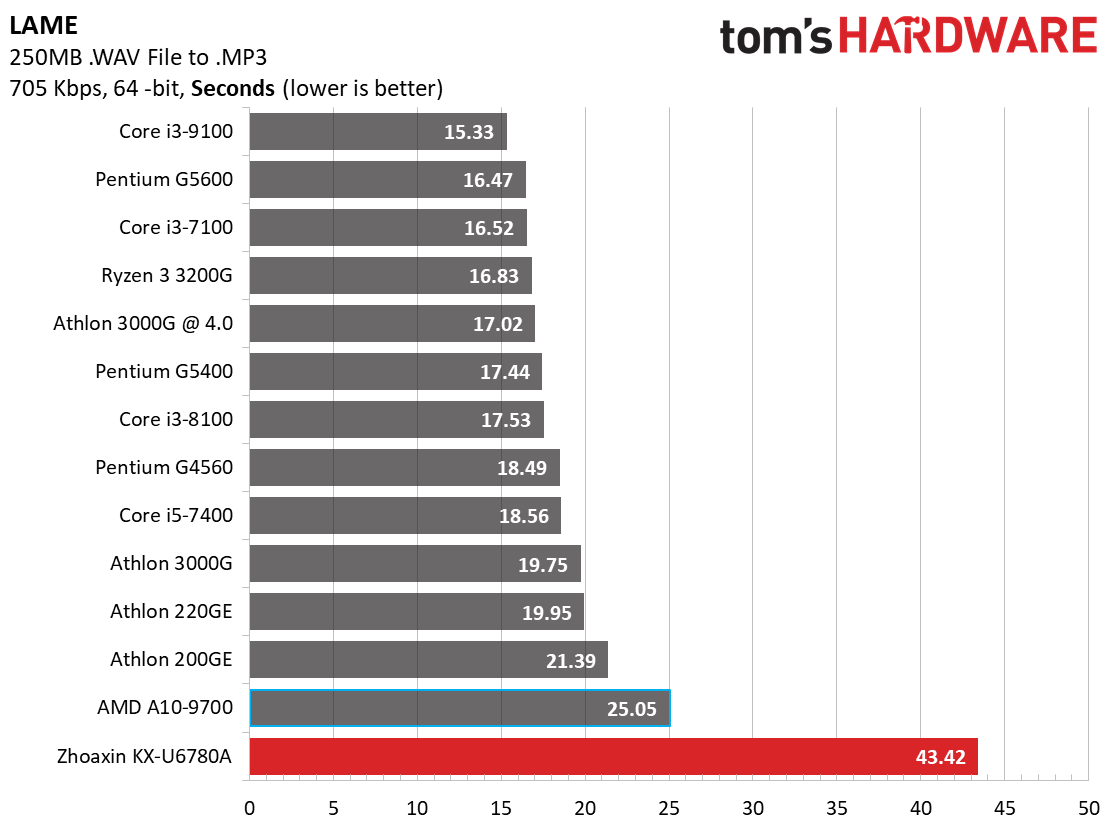
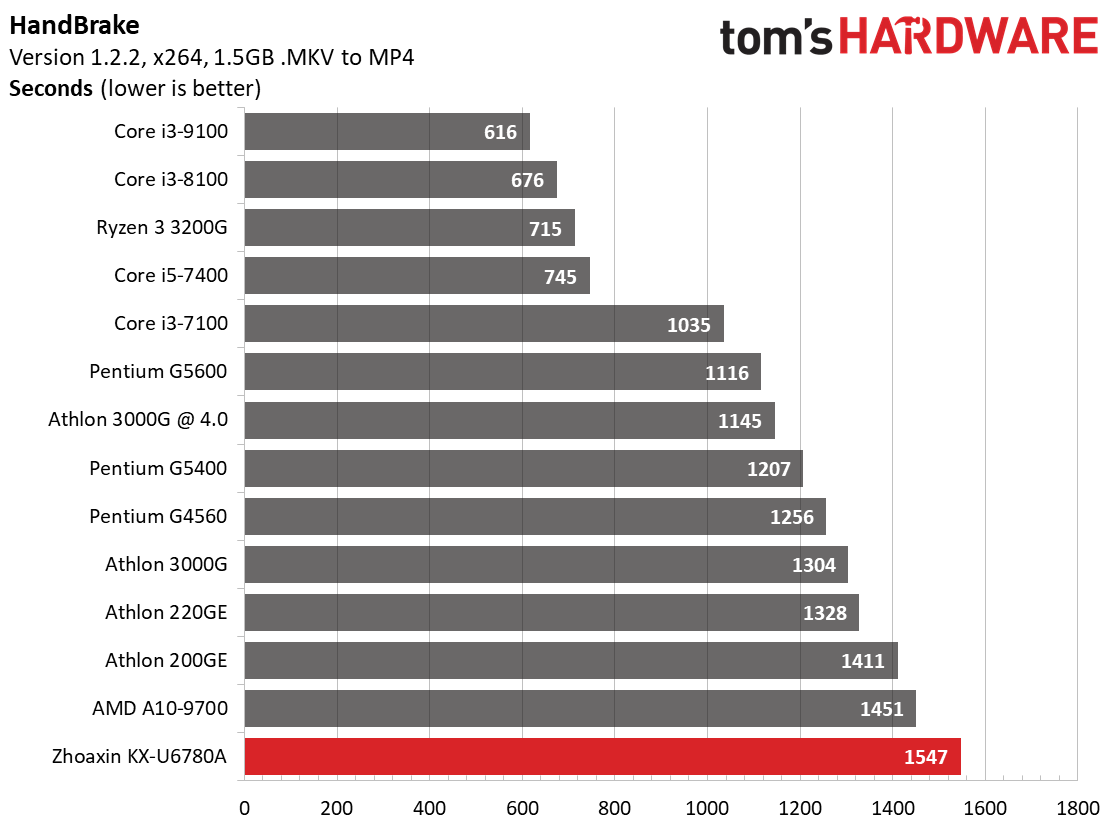
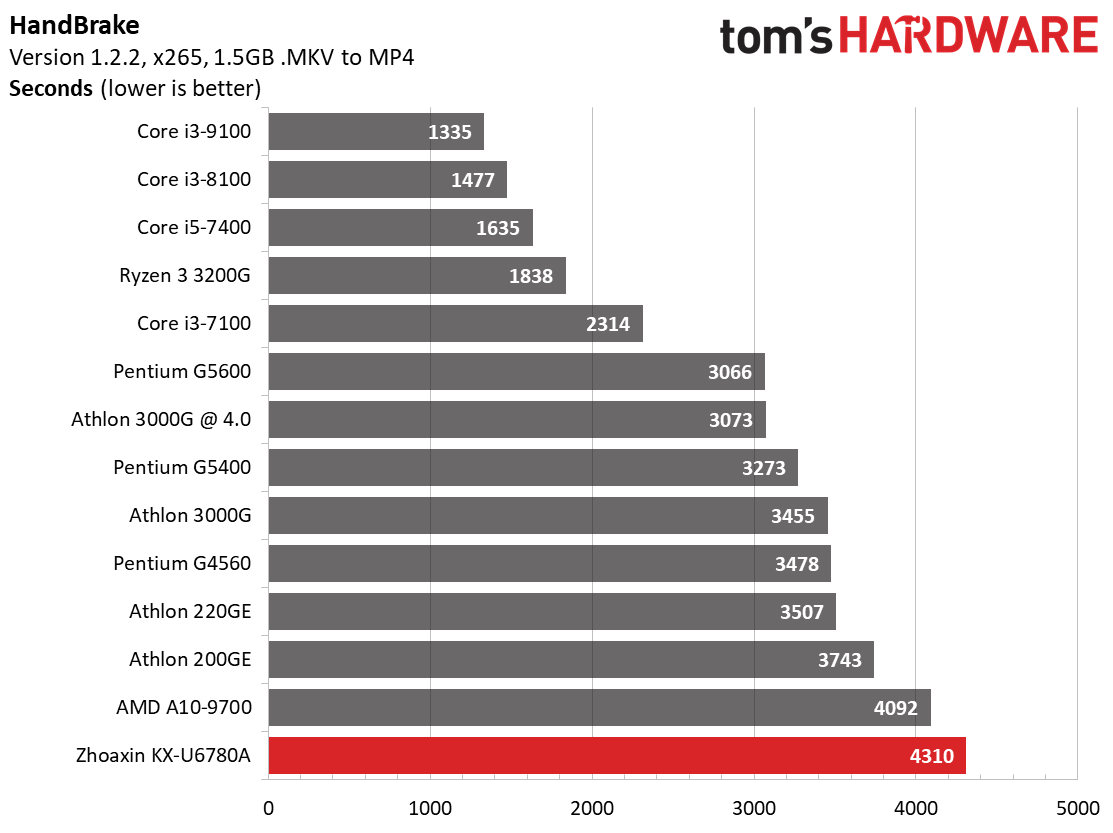
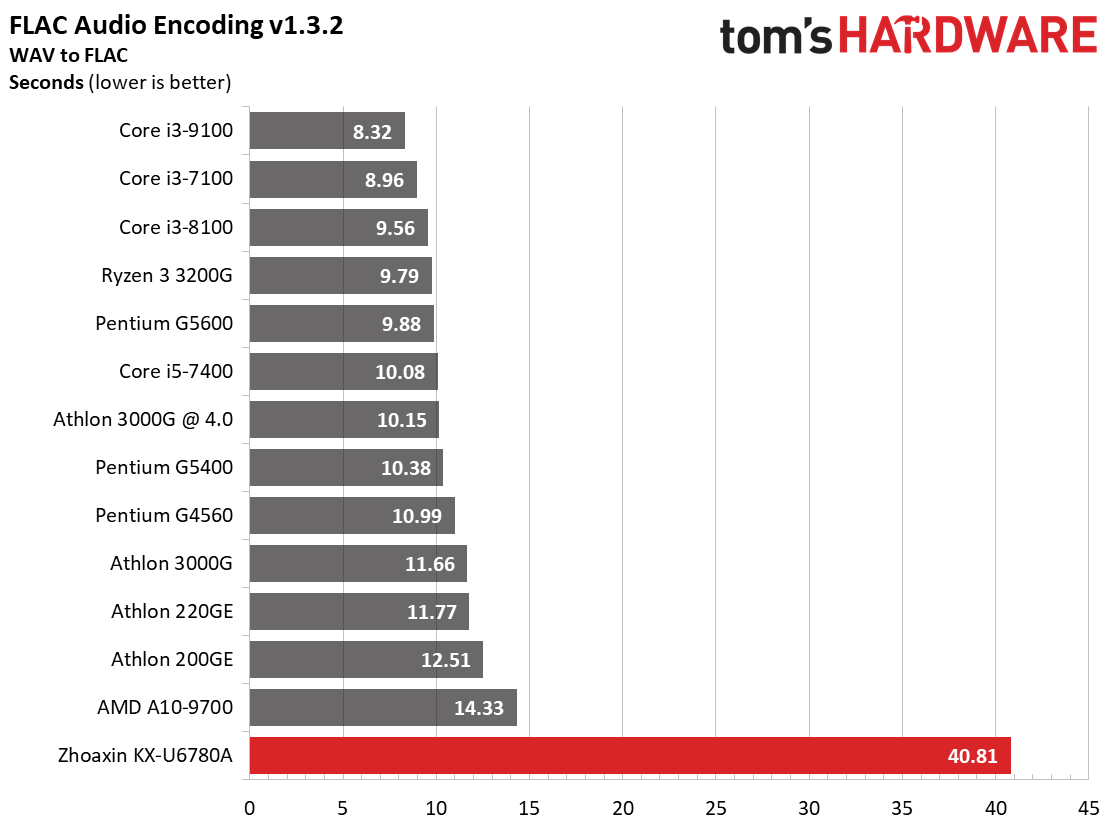
We typically use the Intel/Netflix-designed SVT-AV1 video encoder to test performance in a threaded encoding application, but the Zhaoxin processor repeatedly failed to execute the test properly. That leaves us with the single-threaded LAME and FLAC encoding test results, which both reveal a massive disparity in performance compared to competing chips from both Intel and AMD. This could be a lack of software optimization for the architecture, but it's clear that this single-threaded performance needs to improve drastically in future Zhaoxin architectures through both a combination of higher frequencies and microarchitectural advances.
The threaded HandBrake x264 and x265 tests again reveal the Zhaoxin chip's subpar performance in AVX workloads. The x265 test uses a heavier distribution of AVX instructions than the x264 tests, but even AMD's aging Excavator cores in the A10-9700 outperform the KX-U6780A in both tests.
Get Tom's Hardware's best news and in-depth reviews, straight to your inbox.
Web Browser
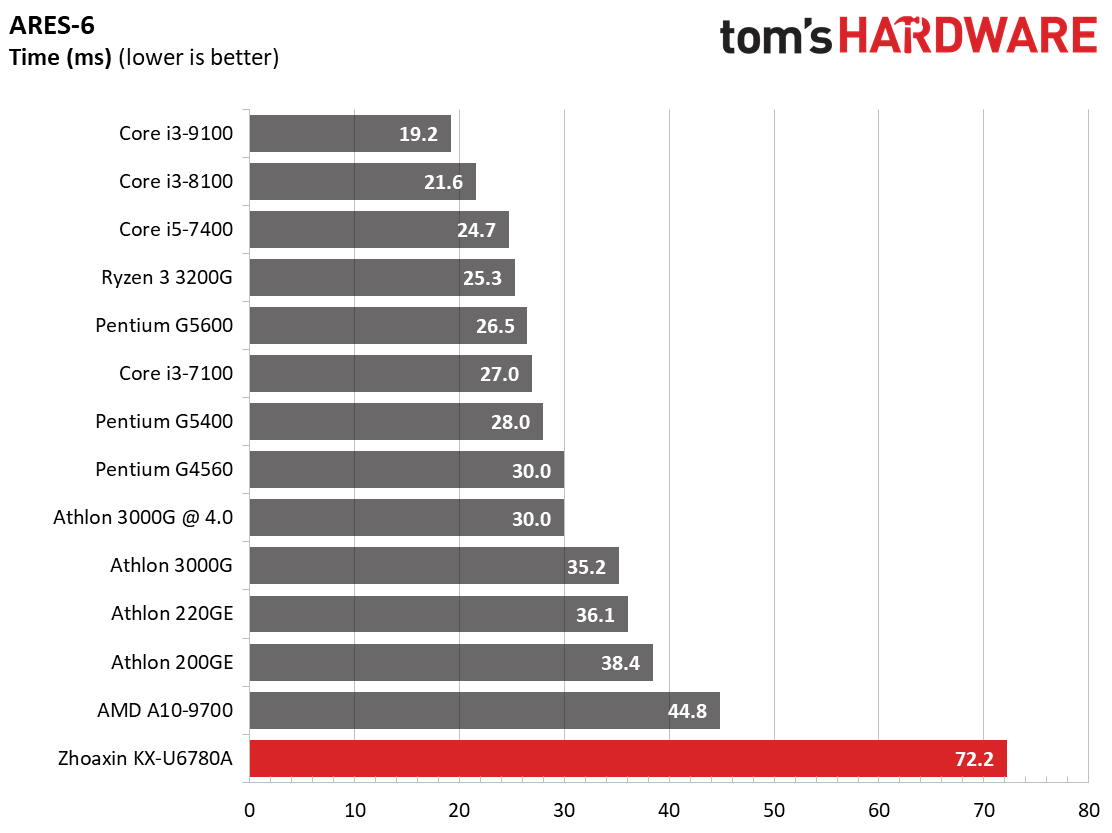


Browsers tend to be impacted more by the recent security mitigations than other types of applications, so Intel has generally taken a haircut in these benchmarks of fully-patched systems. However, neither Intel or AMD face any meaningful competition here from the Zhaoxin processor. The results speak for themselves – the KX-U6780A isn't a contender in lightly-threaded applications.
Office and Productivity
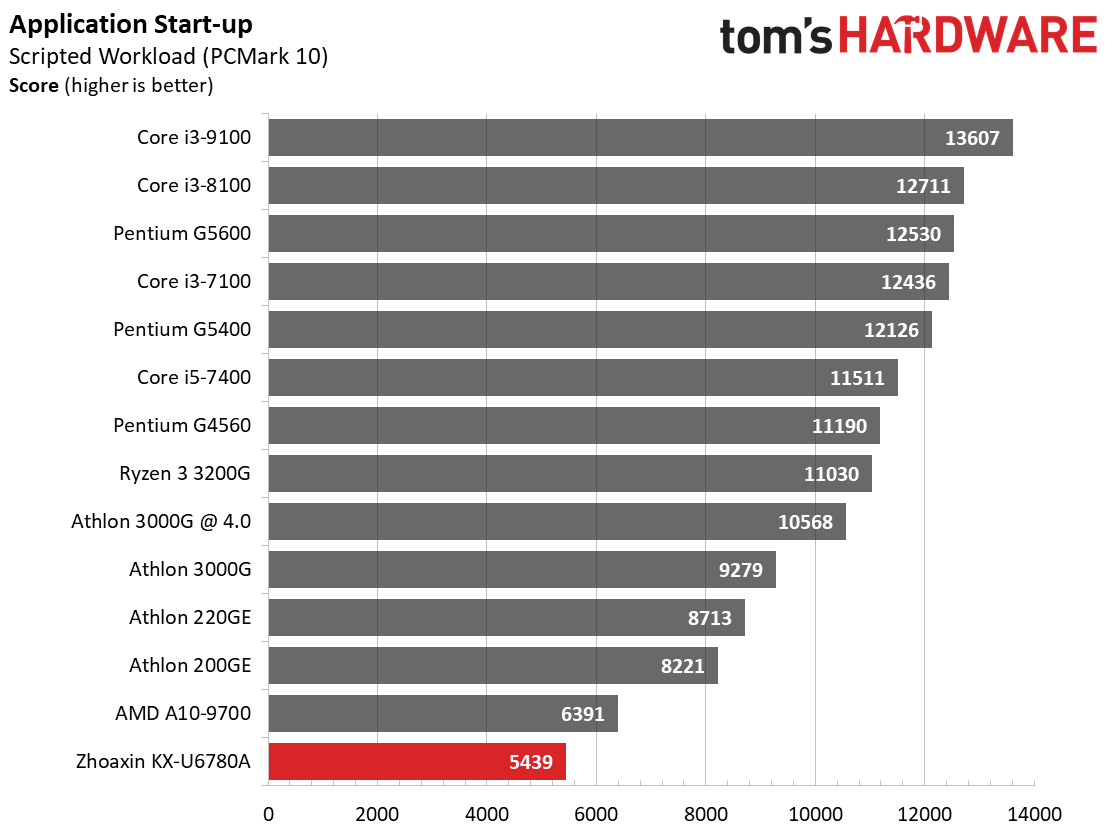
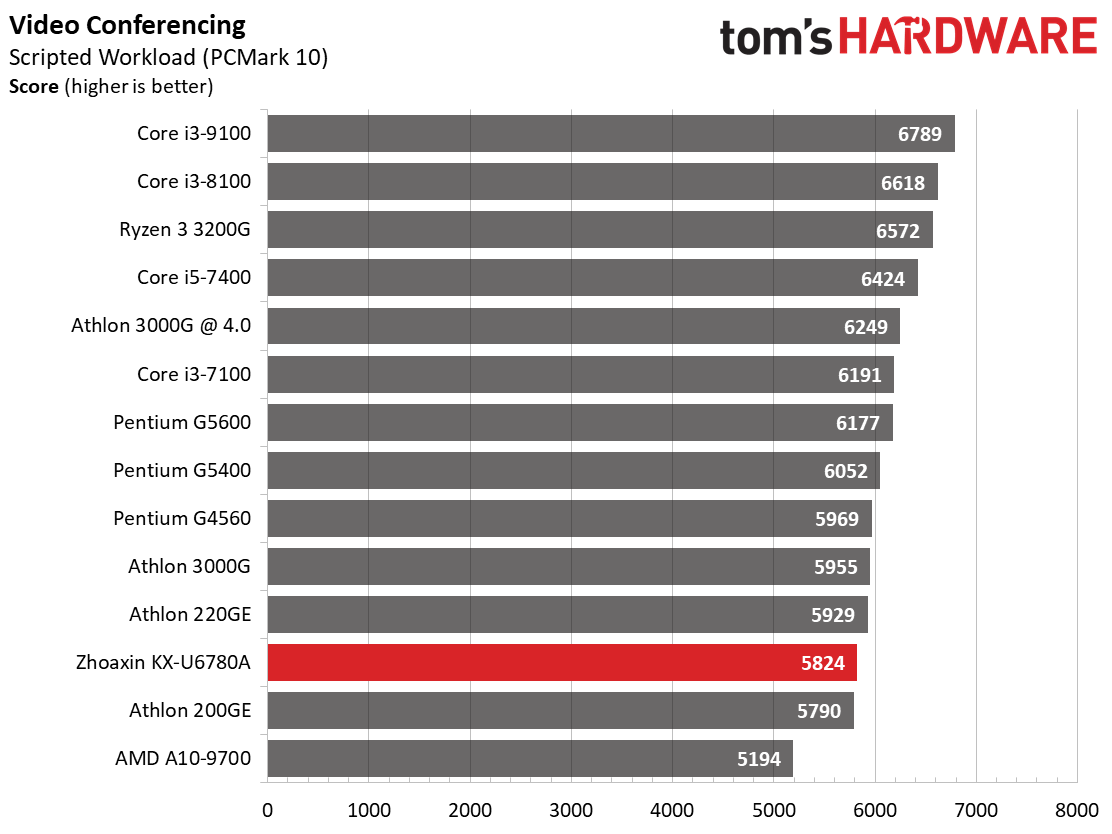
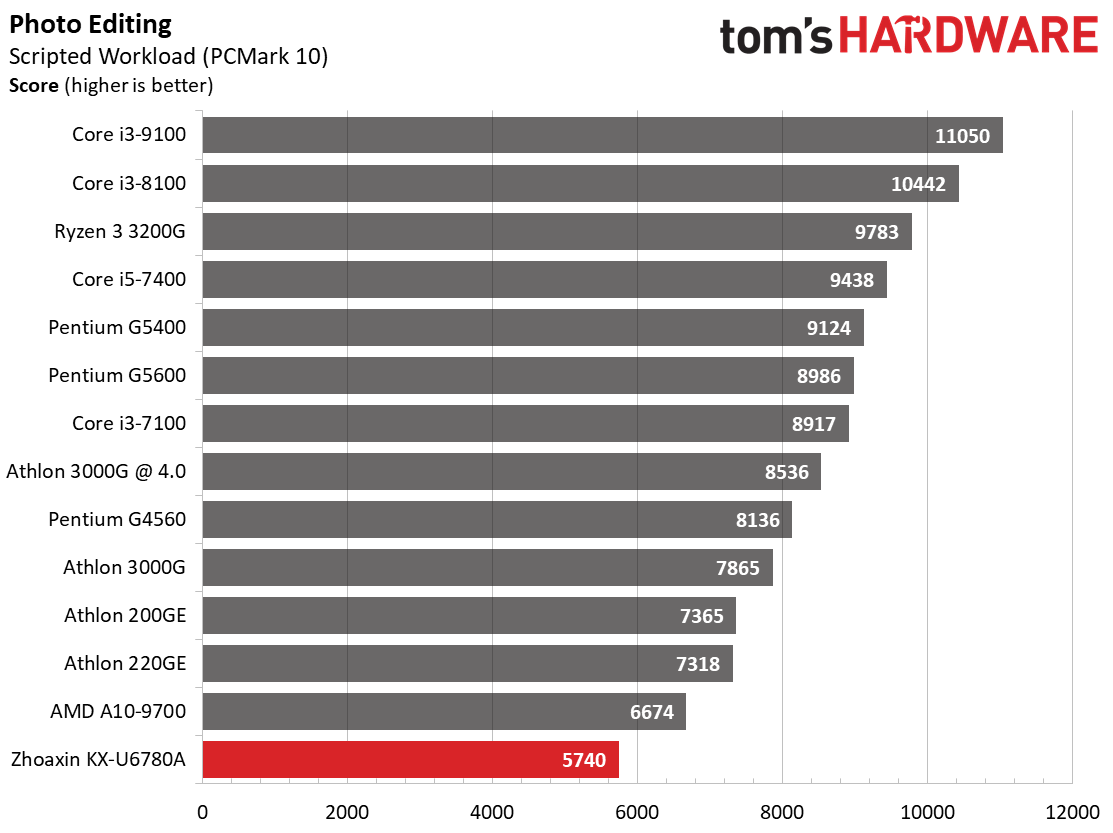
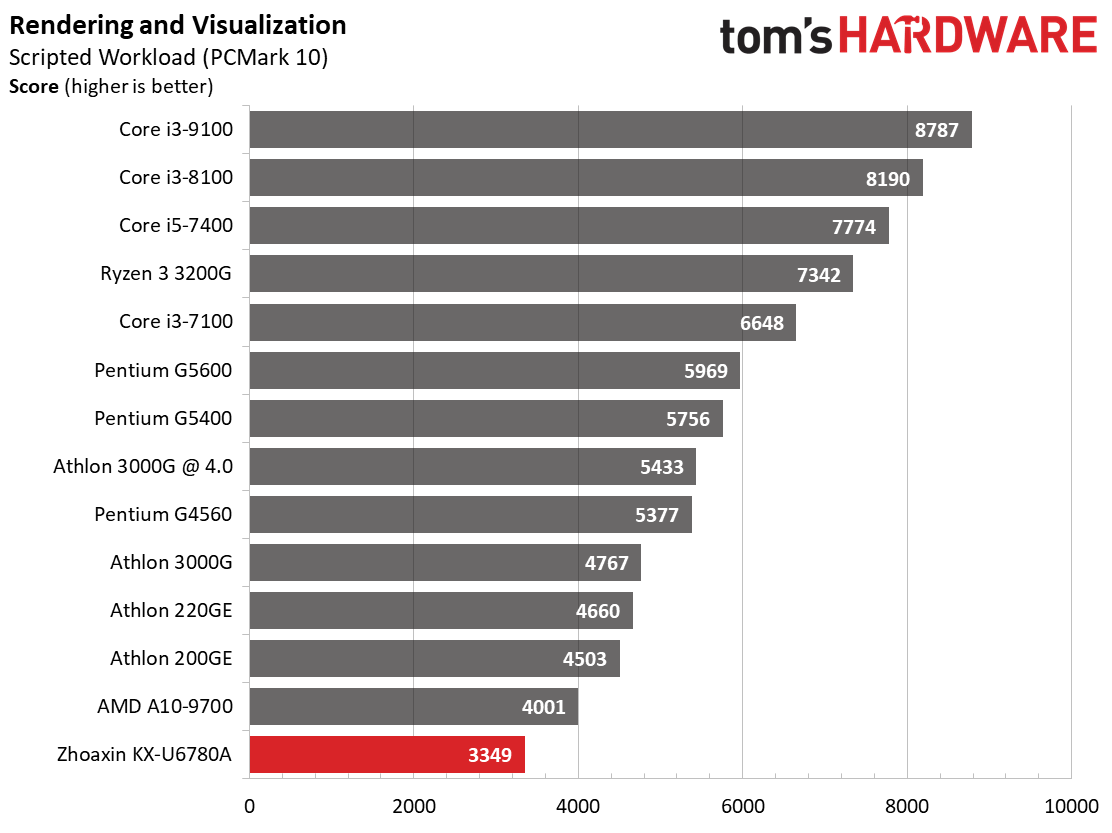

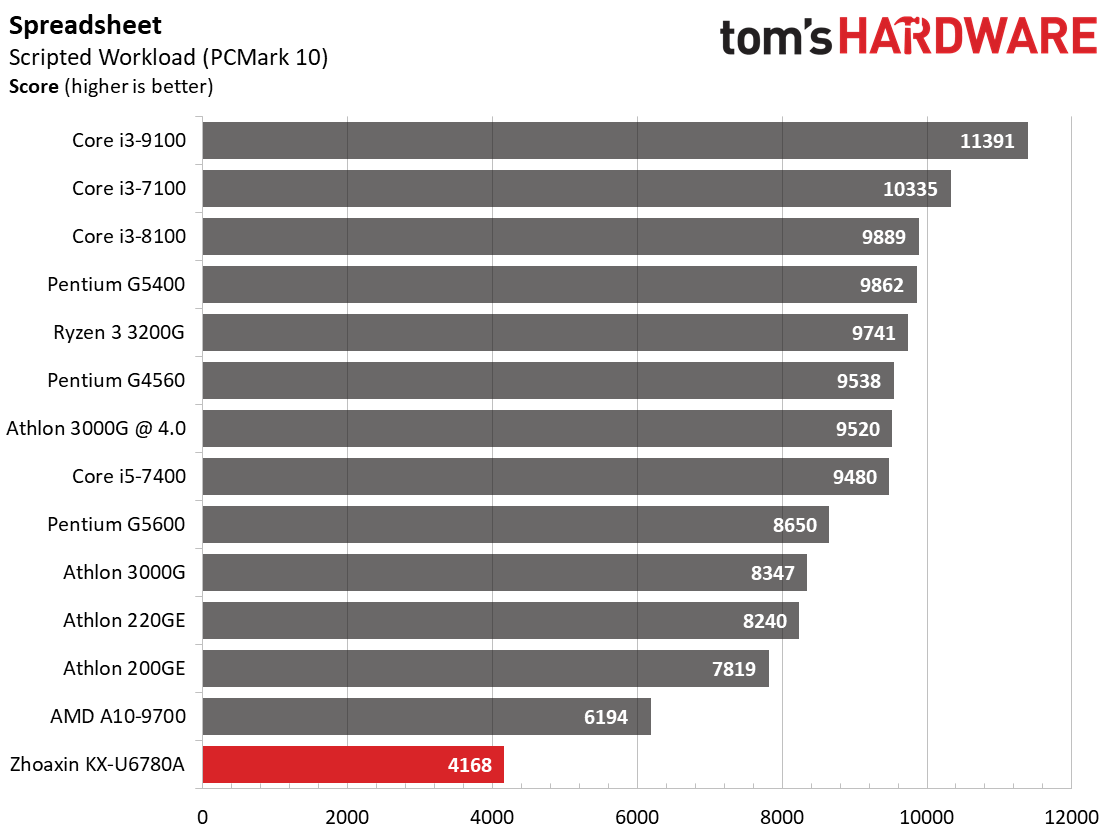
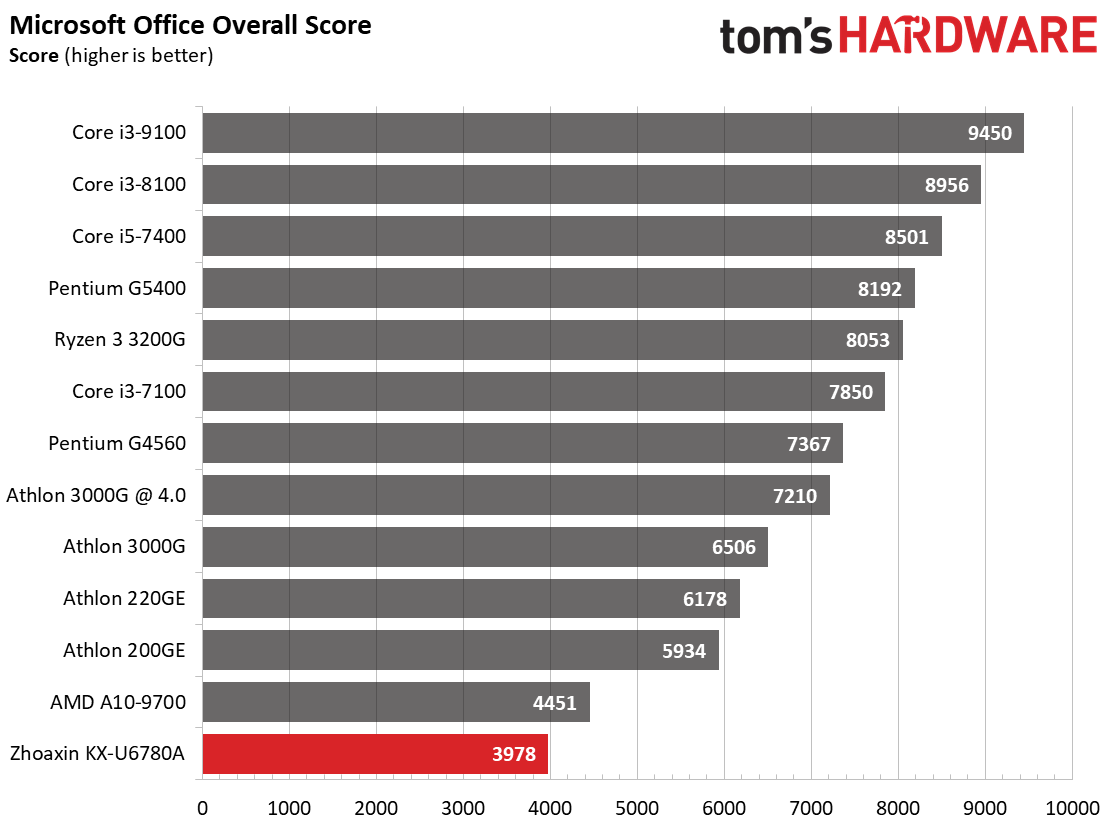

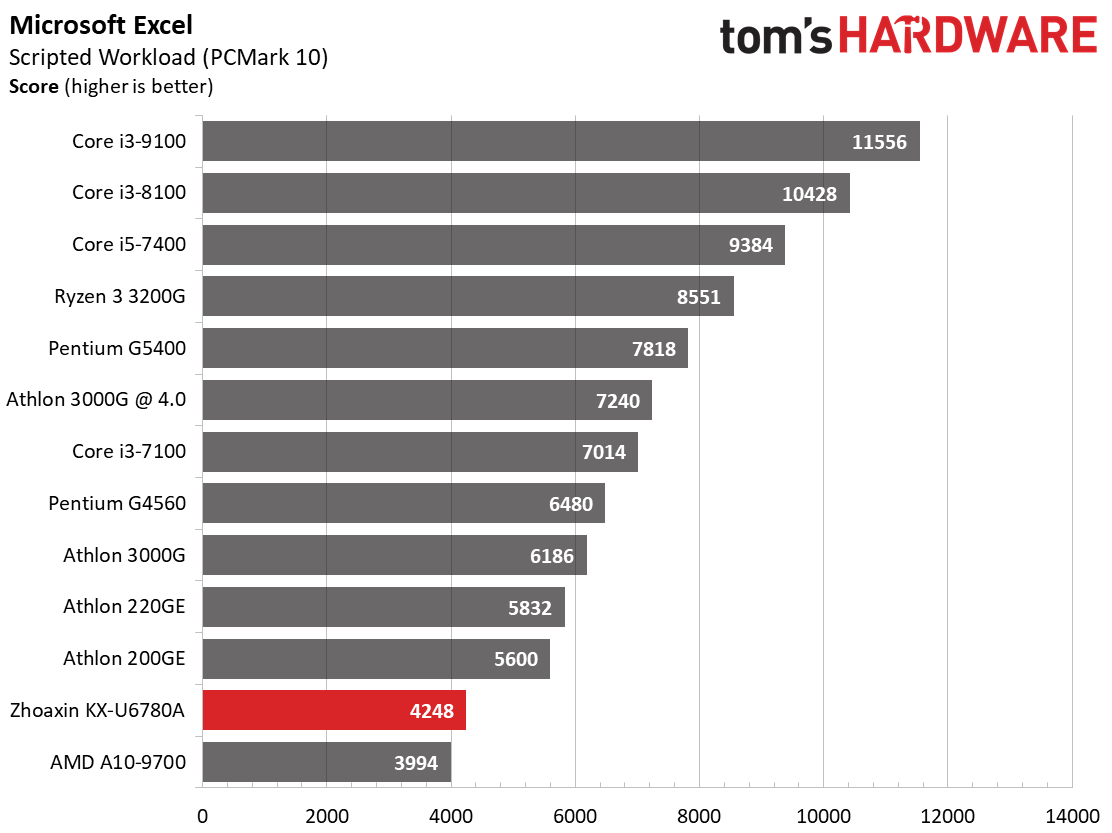
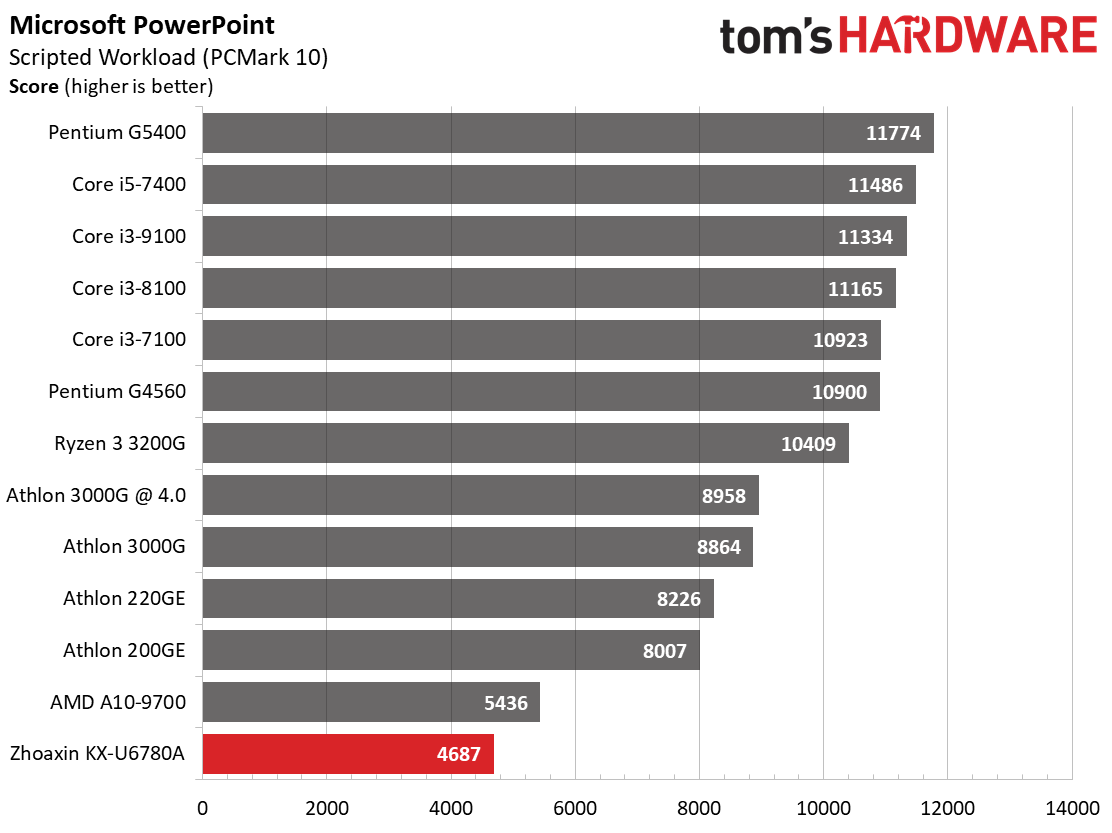
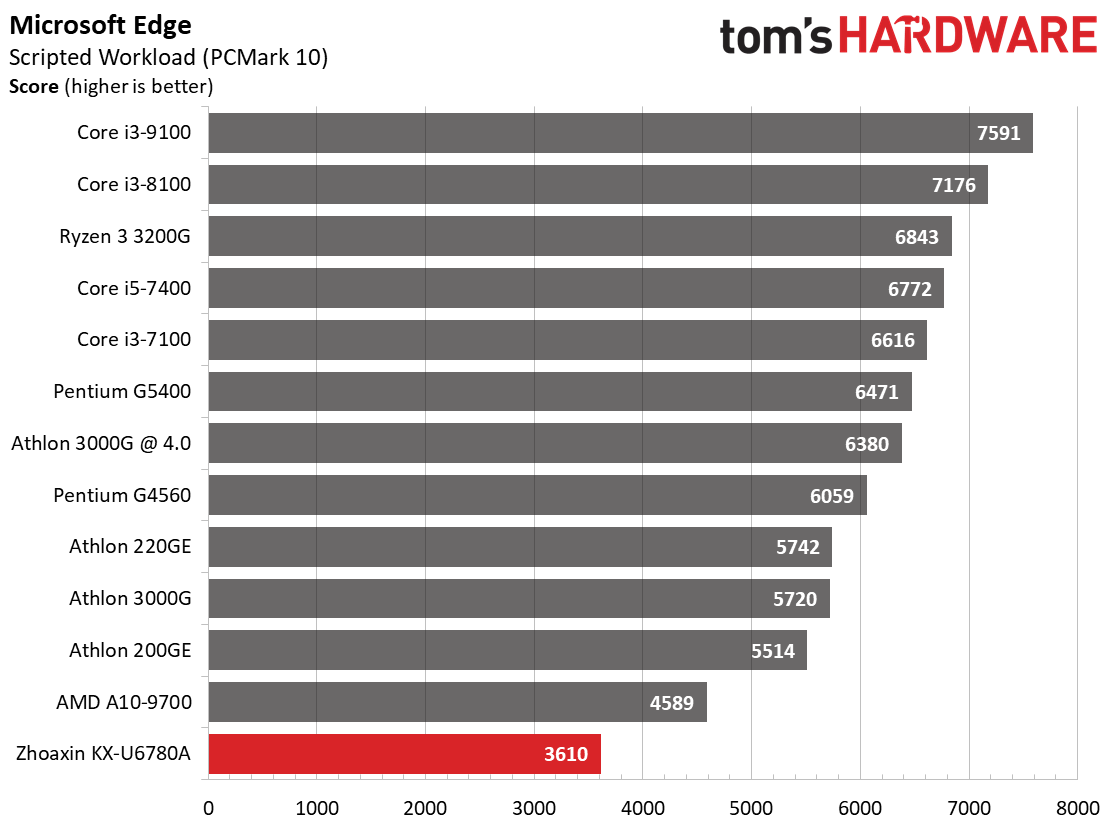

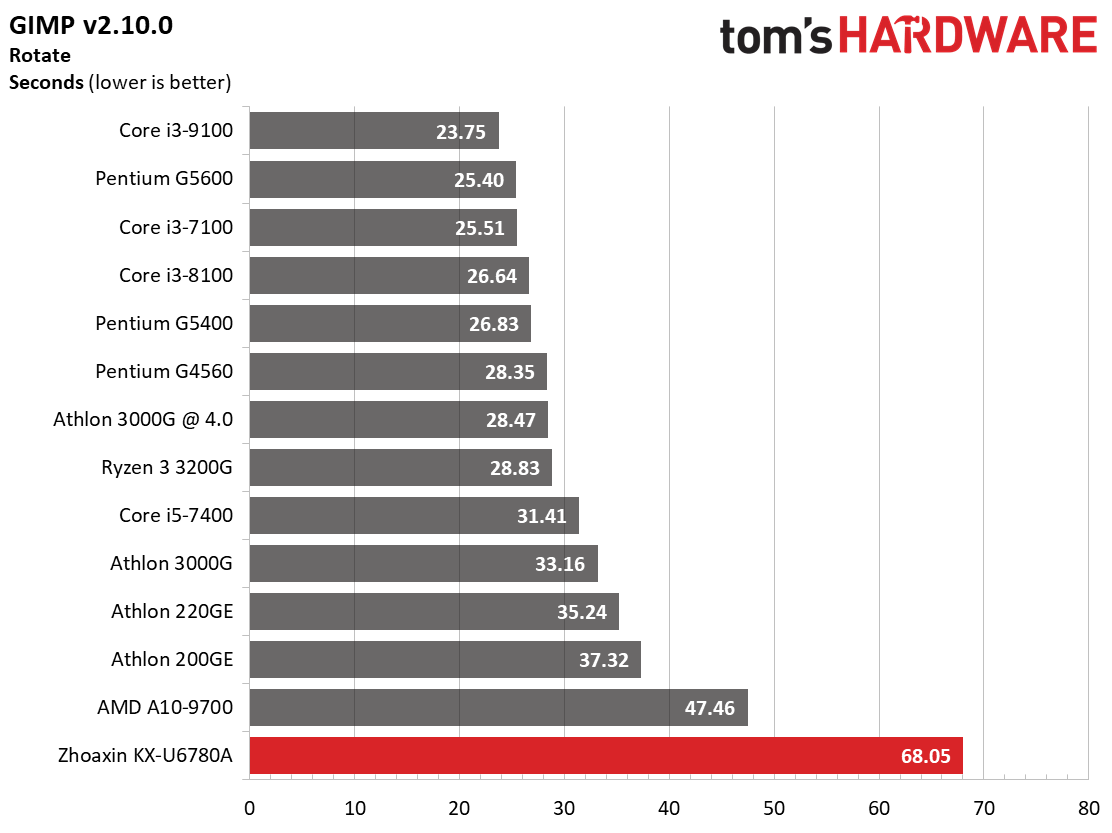
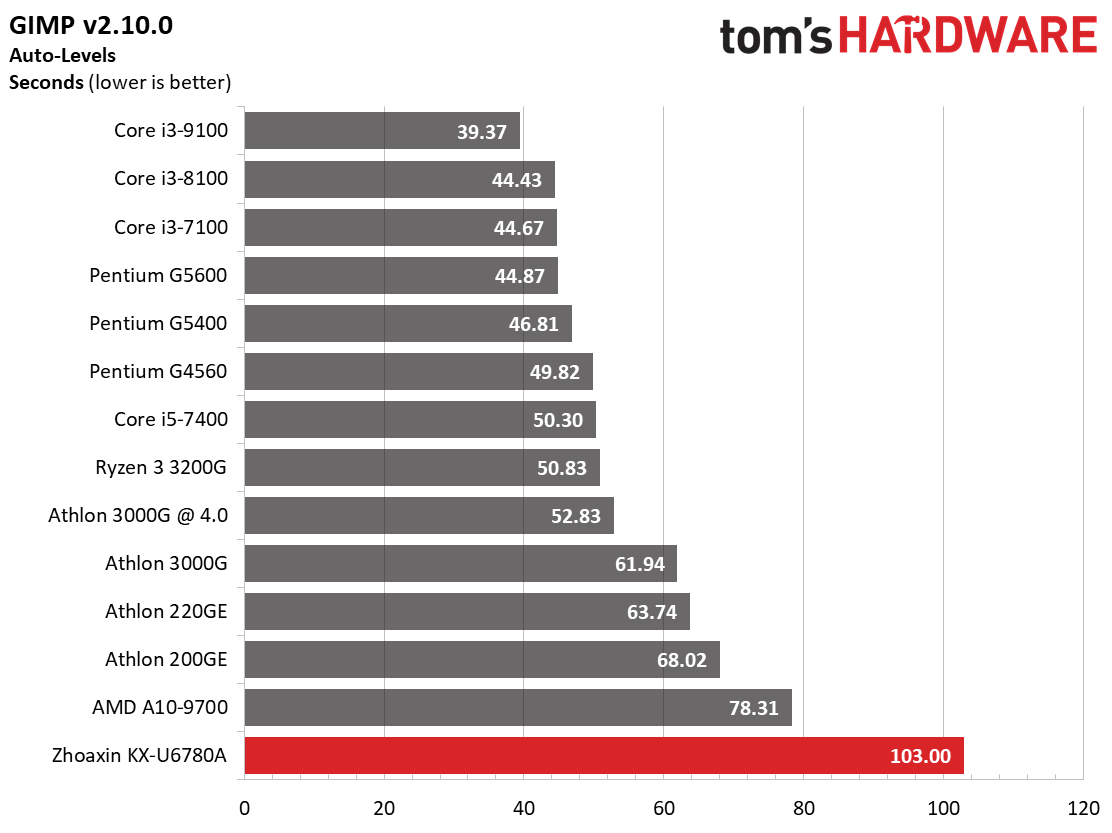

The Zhaoxin processor fails to impress in any of our office and productivity tests as it loses every benchmark by large margins. We expect these chips to find plenty of use in governmental offices, but that will come with a stiff performance penalty and generally sluggish performance in these types of applications.
Compression, Decompression, Encryption, AVX
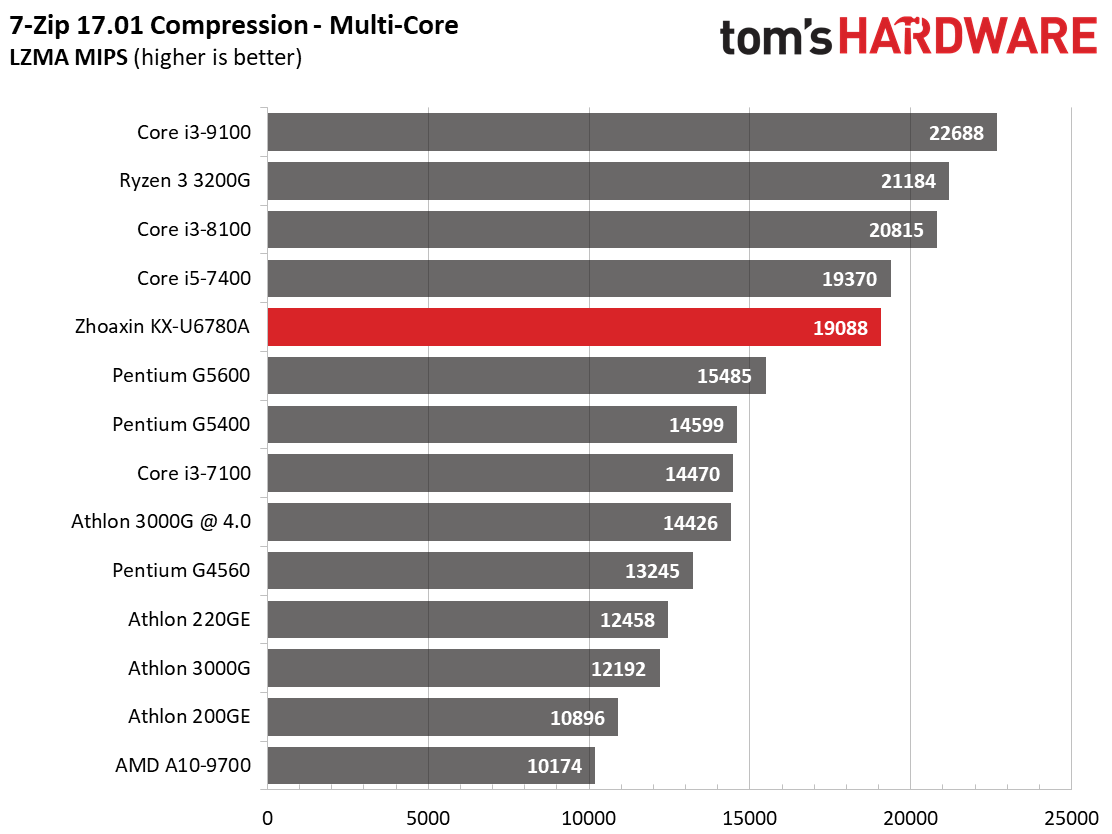
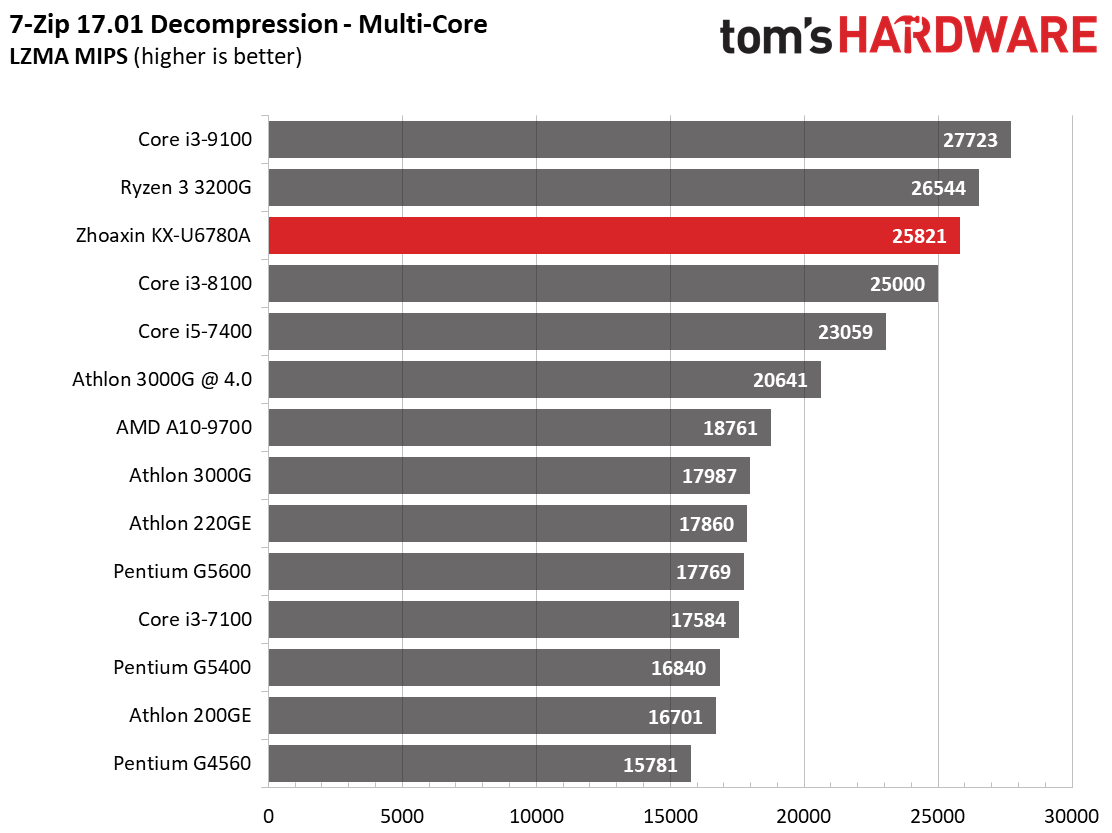

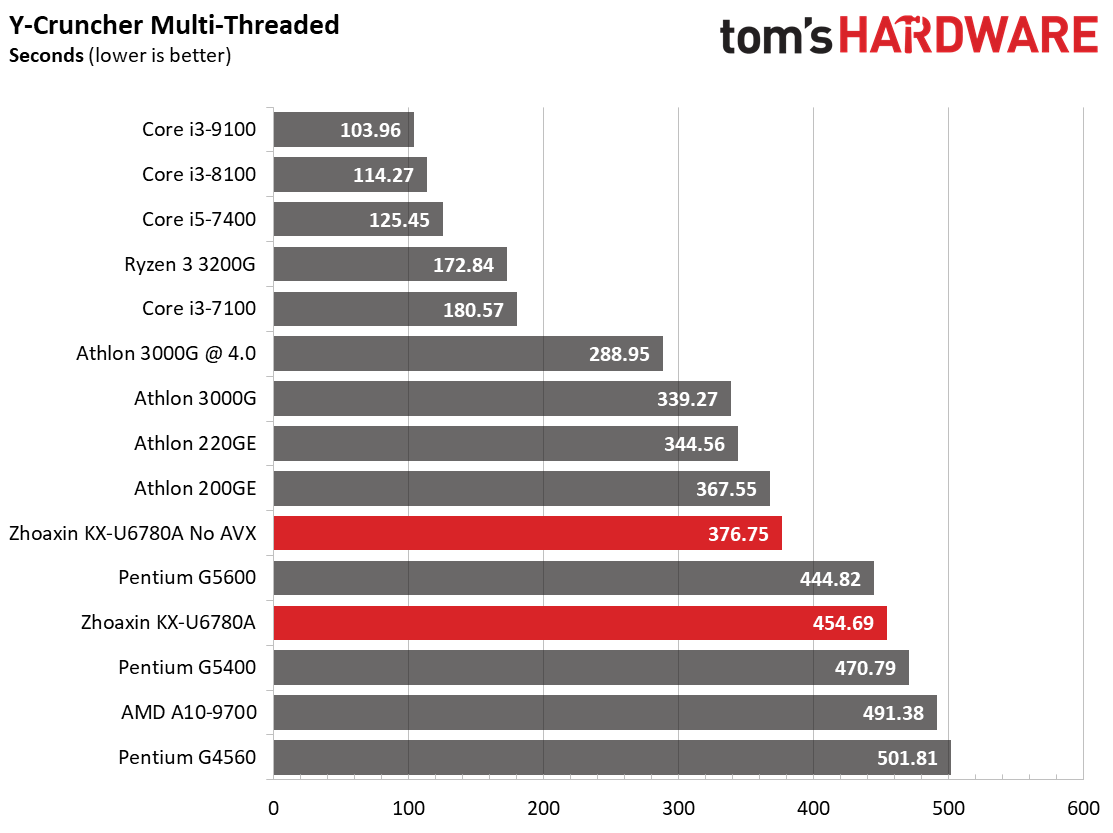
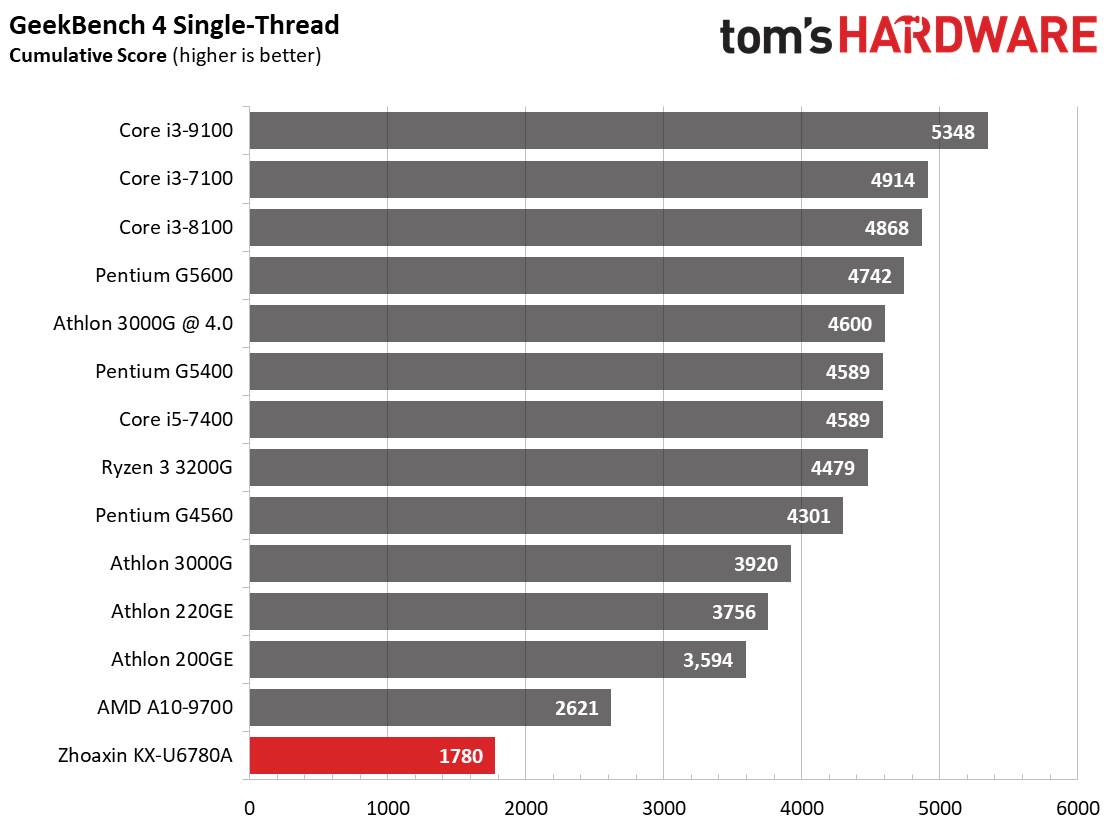



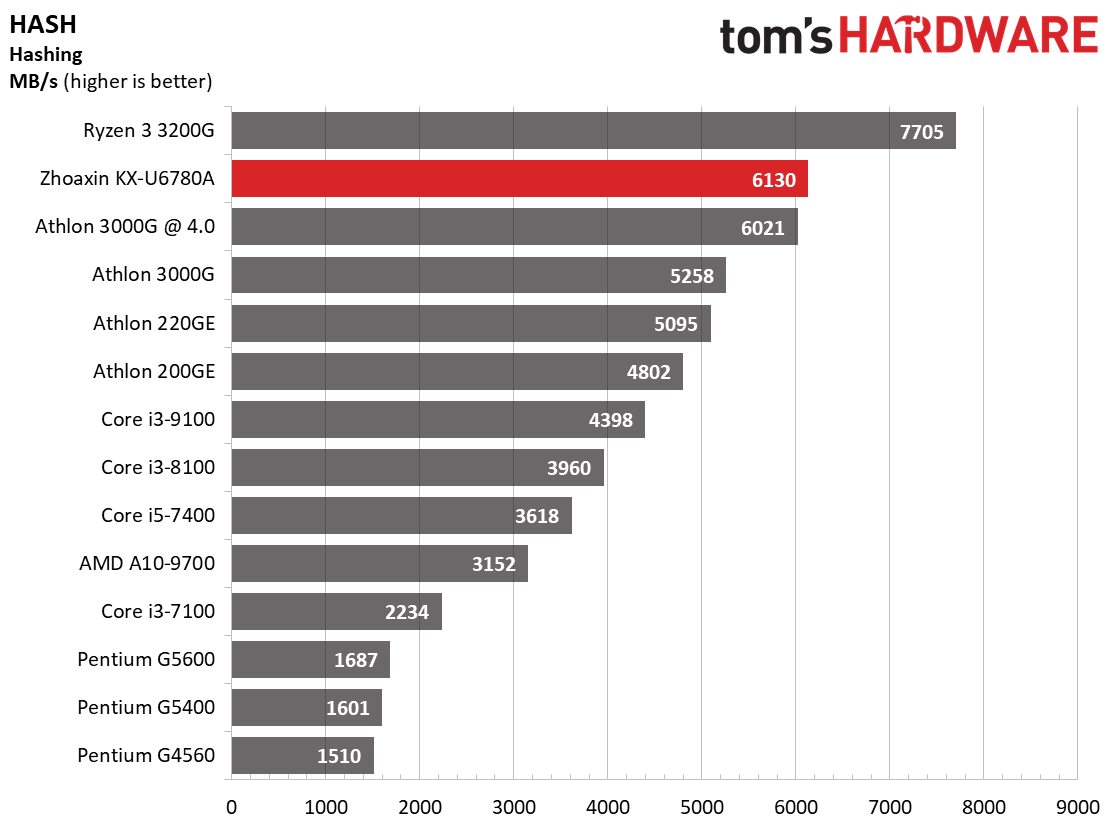
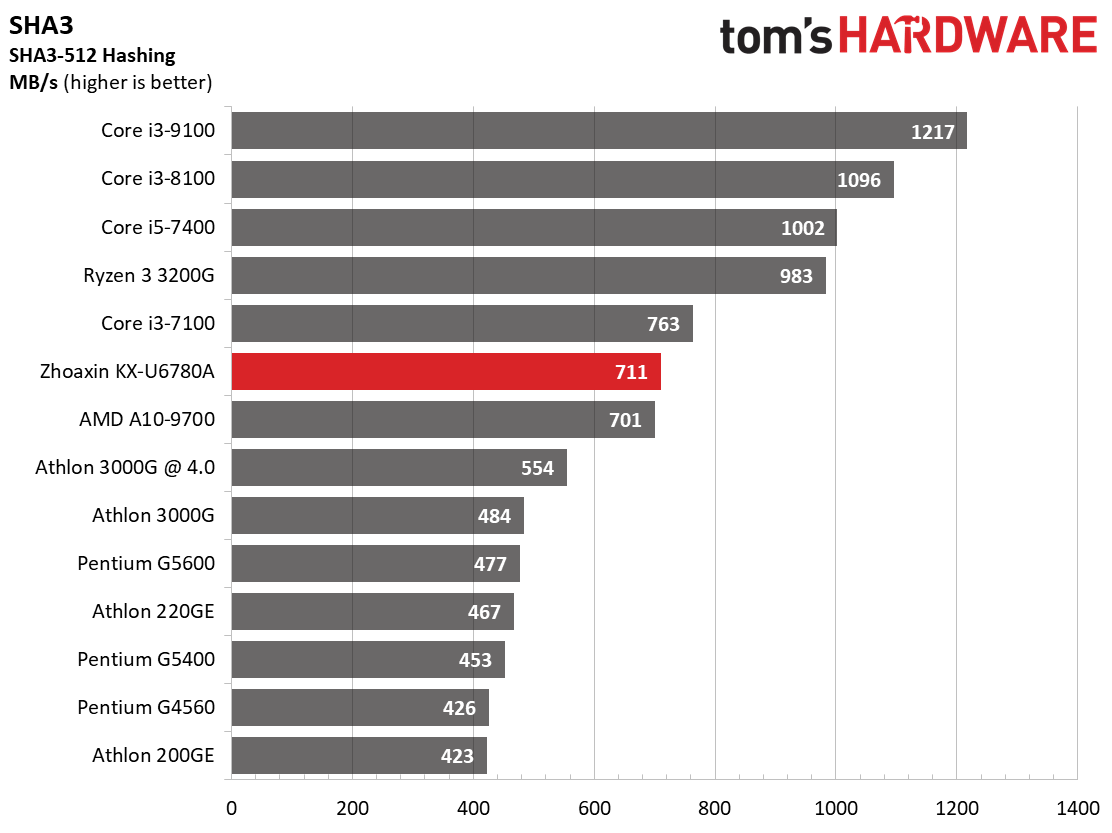
The 7zip and Zlib compression/decompression benchmarks rely heavily upon threading and work directly from system memory, thus avoiding the traditional storage bottleneck in these types of tasks. The KX-U6780A puts up much more impressive performance in these tests as it can utilize its memory throughput and cores to chew through the workloads, besting all but the quad-core Intel processors. AMD's dual-core Ryzen 3 3200G proves its mettle with its four threads as it notches a considerable lead against the Zhaoxin chip in both 7zip decompression and compression workloads.
The heavily-threaded y-cruncher benchmark, which computes pi using the taxing AVX instruction set, finds the Zhaoxin chip getting a nice performance bump by toggling the AVX compatibility feature in the BIOS, but we see the same trend of woeful single-threaded performance offset by the heft of eight cores in the threaded workload. In either case, losing to the $50 dual-core Athlon 200GE in a threaded workload isn't a good look for an eight-core processor.
China's state-defined encryption is a big impetus for its homegrown CPU initiatives, but there aren't any established SM3/SM4 tests available yet from the roster of ISVs that provide reputable test software. We're sending out requests for tests that reflect the advantages/disadvantages of those algorithms. Meanwhile, we can see that the chip provides strong performance in the AES, Hashing, and SHA3 benchmarks.
MORE: Best CPUs
MORE: Intel & AMD Processor Hierarchy
MORE: All CPUs Content
Current page: Zhaoxin Application Performance
Prev Page Zhaoxin Gaming Performance Next Page China on the Rise?
Paul Alcorn is the Editor-in-Chief for Tom's Hardware US. He also writes news and reviews on CPUs, storage, and enterprise hardware.
-
nofanneeded China CPU making Potential is in the ARM not the X86 market ... their Huwawei Kirin ARM CPU is the thing not X86 Chips.Reply -
alextheblue Replywe're looking at roughly the same power draw, if not slightly less, than AMD's A10-9700 that's also fabbed on a 28nm process.
It seems you're implying both chips are fabbed on the same process. The first page says 16nm FinFET.
Even with the somewhat unclear power results, we can clearly see the power burden bestowed by the older 28nm process. -
Paul Alcorn Replyalextheblue said:It seems you're implying both chips are fabbed on the same process. The first page says 16nm FinFET.
Good eye, thanks Alex. Fixed. -
jimmysmitty ReplyRemember AMD's Phoenix-like rise from the relative ashes of the semiconductor market to the value and performance leader?
I do. It only took one daring new architecture with a massive 52% IPC gain paired with a good-enough 14nm GlobalFoundries process, and perhaps a little bit of luck with Intel's delays on the 10nm node, to upset both the desktop PC and data center markets.
Except AMD already had what they needed to meet Intel performance wise and their first step was a catch up after using a uArch that was just bad all around. Bulldozer launched to being beaten by K10.5 CPUs in some areas.
You also have to consider that Intel and AMD had a big settlement a few years ago that allowed for cross patent sharing so AMD has a lot to work with to design.
This CPU is extremely underwhelming and will probably only exist in the Chinese market or places that are too cheap to buy AMD or Intel. -
JarredWaltonGPU Reply
Zhaoxin is at least capable of making x86-64 CPUs, and there's been a pretty decent uplift in performance over its previous gen chip. Still a long way to go, sure, but I don't think closing the uarch gap is going to be that difficult -- especially if patents and licensing are ignored. I'm sure these chips violate hundreds of Intel and AMD patents, but proving that will be difficult, and as long as they remain a China-only product there's not much to be gained by AMD or Intel in trying to fight it.jimmysmitty said:Except AMD already had what they needed to meet Intel performance wise and their first step was a catch up after using a uArch that was just bad all around. Bulldozer launched to being beaten by K10.5 CPUs in some areas.
You also have to consider that Intel and AMD had a big settlement a few years ago that allowed for cross patent sharing so AMD has a lot to work with to design.
This CPU is extremely underwhelming and will probably only exist in the Chinese market or places that are too cheap to buy AMD or Intel. -
Dsplover What a kind review for a crappy chip.Reply
Can’t wait to see the excitement over the next major achievement... -
pug_s ReplyJarredWaltonGPU said:Zhaoxin is at least capable of making x86-64 CPUs, and there's been a pretty decent uplift in performance over its previous gen chip. Still a long way to go, sure, but I don't think closing the uarch gap is going to be that difficult -- especially if patents and licensing are ignored. I'm sure these chips violate hundreds of Intel and AMD patents, but proving that will be difficult, and as long as they remain a China-only product there's not much to be gained by AMD or Intel in trying to fight it.
Zhaoxin exist only because China's contingency plans if they are not allowed to buy intel or AMD desktop processors. Thanks to Obama's and Trump's exclusion to buy US technologies, China's 2025 plans is to get away from US technologies in the next few years. In the next few years, the Chinese government will probably use some kind of Linux dist using Risc V chips utilizing open source software. -
Gurg For reference, performance in Fire Strike Physics is about 87% of the 7857 score generated by my old 2700K eight years ago.Reply -
jimmysmitty ReplyJarredWaltonGPU said:Zhaoxin is at least capable of making x86-64 CPUs, and there's been a pretty decent uplift in performance over its previous gen chip. Still a long way to go, sure, but I don't think closing the uarch gap is going to be that difficult -- especially if patents and licensing are ignored. I'm sure these chips violate hundreds of Intel and AMD patents, but proving that will be difficult, and as long as they remain a China-only product there's not much to be gained by AMD or Intel in trying to fight it.
It's an extremely long way to go. Its using more power and in a lot of cases giving half the performance of an i3.
I don't see AMD or Intel fighting it but still even in China this will only sell well to basic users if that unless the government limits or stops sales from AMD and Intel. No one wants to pay money for a product thats that far behind.